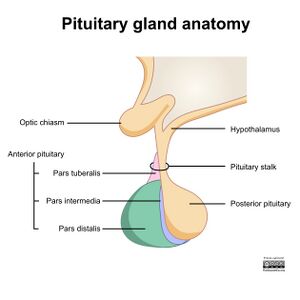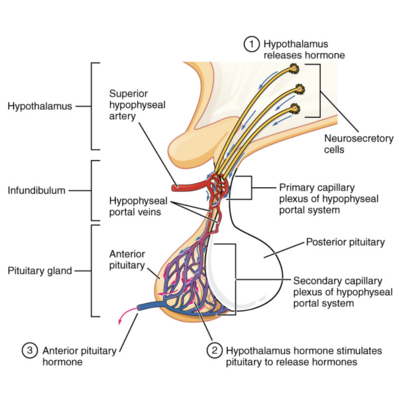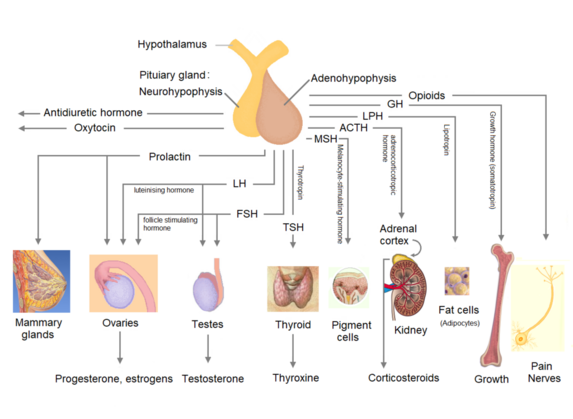Pituitary Gland
Original Editor - Lucinda hampton
Top Contributors - Lucinda hampton
Introduction[edit | edit source]
The pituitary gland is a tiny but vital organ acting as the main endocrine interface between the central nervous system and the entire body, the so called master gland. It is a pea sized organ found at the base of the brain in a bony hollow, just behind the bridge of your nose .[1][2] The hypothalamus, just above it, is part of the brain and controls the pituitary by sending it messages.[3] The anterior pituitary has blood vessels connecting it to the hypothalamus whilst the posterior pituitary has neural connections.
The below video introduces you the the pituitary gland, a very important gland for the sustainability of life.
Divisions[edit | edit source]
Anterior pituitary (AP): Largest part of the gland. The hypophyseal portal system (a system of blood vessels) connects the hypothalamus and the anterior pituitary, allowing endocrine communication between the hypothalamus and the anterior pituitary gland[5]. Six hormones are secreted from the AP , each with a specific functions and target organs:
- Growth hormone (somatotropin)
- Thyroid stimulating hormone (TSH)
- Adrenocorticotropic hormone (ACTH)
- Follicular stimulating hormone (FSH)
- Luteinizing hormone (LH)
- Prolactin
Posterior pituitary: The posterior pituitary is connected directly to the hypothalamus via a nerve tract (hypothalamohypophyseal nerve tract). Oxytocin and antidiuretic hormones are synthesised in the hypothalamus and travel down the nerve tract to be released in the posterior pituitary.[6]
Pathology[edit | edit source]
Pituitary disorders are distinguished by excess amounts of, or a deficiency in, one or more of the hormones produced by the pituitary gland and/or by the symptoms that occur when a tumour compresses the surrounding tissues.Pathological changes often effect this pituitary gland. Pituitary adenomas are present in 14% of autopsy studies and 23% of radiology studies.[6]
The more common pituitary conditions include:
- Hyperprolactinaemia (too much prolactin in the blood).
- Growth hormone deficiency: can delay children’s growth and lead to a child being shorter in height than expected. In adults, the symptoms of growth hormone deficiency include fatigue, weak muscles and bones, excess weight, anxiety, mood problems or sleep problems.
- Hypopituitarism: a deficiency of all the pituitary hormones and causes many different symptoms.
Uncommon pituitary conditions include:
- Gigantism — where a person grows very tall
- Acromegaly — where a person’s hands, feet and jaw enlarge
- Cushing’s syndrome — where the body creates too many steroid hormones
References[edit | edit source]
- ↑ Banas A, Banas K, Furgal-Borzych A, Kwiatek WM, Pawlicki B, Breese MB. The pituitary gland under infrared light–in search of a representative spectrum for homogeneous regions. Analyst. 2015;140(7):2156-63. Available:https://pubmed.ncbi.nlm.nih.gov/25574521/ (accessed 14.1.2023)
- ↑ Radiopedia Pituitary Gland Available:https://radiopaedia.org/articles/pituitary-gland (accessed 14.1.2023)
- ↑ The pituitary foundation What is the pituitary gland? Available:https://www.pituitary.org.uk/information/what-is-the-pituitary-gland/ (accessed 14.1.2023)
- ↑ Swedish. What is the Pituitary Gland?. Available from: https://www.youtube.com/watch?v=qJj_-3dZ4ZQ [last accessed 15.1.2023]
- ↑ Gargiulo AR. Yen & Jaffe's reproductive endocrinology: Physiology, pathophysiology, and clinical management. Elsevier Health Sciences; 2017 Dec 23.Available:https://www.sciencedirect.com/book/9781416049074/yen-and-jaffes-reproductive-endocrinology (accessed 15.1.2023)
- ↑ 6.0 6.1 El Sayed SA, Fahmy MW, Schwartz J. Physiology, pituitary gland.Available:https://www.statpearls.com/articlelibrary/viewarticle/767/ (accessed 14.1.2023)









